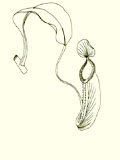

 |
 |
Vertebrates (pdf)
| Feral / stray dogs and civet mortality on Kau Sai Chau, 2001-2 | |
| Sightings of 'overseas' colour-ringed Black-faced Spoonbills in Hong Kong | |
| Pipistrelles use bat roost boxes on Kau Sai Chau |
Sightings of ‘overseas’ colour-ringed Black-faced Spoonbills in Hong Kong
by Y.T. Yu
The Black-faced Spoonbill (Platalea minor) is a globally endangered species and its known population is less than 1000 individuals (BirdLife International 2000). Studies for discovering its migration route were conducted in 1998 and 1999 (Ueta et al. 2002). A total of 34 Black-faced Spoonbills (22 from Hong Kong and 12 from Taiwan) were trapped and given colour rings.
On 5 and 6 November 2002, I found two colour-ringed Black-faced Spoonbills in Mai Po, which did not carry Hong Kong rings. One spoonbill carried a short blue ring on the left leg and a long blue ring with white words ‘T11’ on the right leg on 5 November. The bird also carried a transmitter on the back as the antenna was visible. The other bird was seen on 6 November and carried a small yellow ring on the left leg and two short rings on the right leg, which were red above and green below.
From various references, the ‘T11’ bird received the rings from Taiwan in December 1998 (Ueta et al. 1999) and the ‘three-ringed’ bird was ringed as a chick in the nest in North Korea in July 1995. These are the first recorded sightings of ‘overseas’ Black-faced Spoonbills in Hong Kong. Spoonbills ringed in Mai Po have been seen again in Mai Po (Anon. 2001), in the Tsengwen Estuary of Taiwan (Yu pers. obs.) and at Liaoning (Lei 2002). The three-ringed spoonbill was first found in Japan, in December 1995. I then saw it in Xuan Thuy, Vietnam in December 1999 (Yu and Swennen pers. obs.). This is therefore the first record of an individual of this species visiting three different wintering sites. In addition, this bird, which is now 7 years old, provides the first longevity record for this species.
Acknowledgements
I thank Mr. Simba Chan, from the Wild Bird Society of Japan, for providing information on the colour-ringed Black-faced Spoonbills.
Bibliography
Anon. (2001). Preparation of a Conservation Plan of the Black-faced Spoonbill Platalea minor in Hong Kong. Technical Report 2 – Additional Works. Unpublished report by WWF Hong Kong to the Agriculture, Fisheries and Conservation Department, Hong Kong SAR Government, 55 pp.
BirdLife International. (2000). Threatened Birds of the World. Lynx Ediciones and BirdLife International, Barcelona and Cambridge, UK. 852 pp.
Lei, F.M. (2002). The Black-faced Spoonbill and its conservation status. In: Proceedings of the 2nd Conference on the status and conservation of Hong Kong Wild Animals and Plants: 9-20. Wildlife Conservation Foundation, Hong Kong.
Ueta, M., Kurosawa, R. & Allen, D. (eds.). (1999). Conservation and Research of the Black-faced Spoonbills and their habitats. Proceedings of the international workshop in Tokyo, 12-16 June 1997. Wild Bird Society of Japan, Tokyo.
Ueta, M.J., Melville, D.S., Wang, Y., Ozaki, K., Kanai, Y., Leader, P.J., Wang, C.C. & Kuo, C.Y. (2002). Discovery of the breeding sites and migration route of Black-faced Spoonbills Platalea minor. Ibis 144: 340-343.
|
|
P.9-10 |
|
Porcupine! |
 Copyright © 2000 |